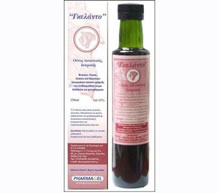
Λεξικό .. Allergic alveolitis
Allergic alveolitis
A granulomatous interstitial disease which results from prolonged inhalation of particulate organic dust. The granulomas involve both macrophages and lymphocytes, mainly CD8+ suppressor T cells, producing a range of proinflammatory cytokines. Cytokine production, which augments pulmonary granuloma formation, includes IL-1 and TNF-a, and the airway response can be reduced using anti-TNF-in silicosis, as well as allergic alveolitis. The various forms of extrinsic allergic alveolitis form a proportion of 2.3% among the spectrum of bronchopulmonary diseases.
The most frequent entities are farmer's lung, bird fancier's lung or bird-keeper disease or bird breeder's disease, or pigeon-fancier's disease, air conditioning disease and humidifier lung or disease, detergent-factory worker's disease, cheese-maker's disease, mushroom-cultivator's/grower's disease, bark-rind-worker's disease, tomato-cultivator's disease, malster's lung, bagasosis, suberosis, sequoisis [1]. Extrinsic allergic alveolitis (hypersensitivity pneumonitis), especially humidifier lung, has been more frequently diagnosed over the last decades, whereas farmer's lung has decreased over the same time period [2]. All of these diseases share the following characteristics: 1) Primarily caused by inhaling organic material, especially mould, 2) Lead to alveolitis and, to a lesser degree, asthma. 3) They are associated with general symptoms resembling those of influenza.
4) They are based on a mixture of type III (immunocomplex) and type IV (cellular immunity) sensitivity. Bronchoalveolar lavage (BAL) has become a valuable tool in the diagnosis of interstitial lung diseases, including extrinsic allergic alveolitis. The typical BAL profile in this disease shows an increase in total cell counts, a marked increase in the percentage of lymphocytes with a decreased CD4/CD8 ratio and an increase in Leu7+ - NK cells, a small increase in neutrophils, the presence of few plasma cells, mastocytes, and of foamy alveolar macrophages. BAL is the most sensitive method to detect the underlying alveolitis, more sensitive than chest radiography, lung function tests or precipitins. A normal BAL cytology or an isolated increase in neutrophils is almost exclusive of an allergic alveolitis. The BAL does not discriminate, however, between subjects with subclinical alveolitis only (i.e. sensitized subjects without disease and patients with true interstitial lung disease. Serial BAL may by useful to reveal incomplete allergen avoidance [1]. Two types of the chronic course of extrinsic allergic alveolitis can be distinguished. The recurrent chronic course with a good prognosis may be differentiated from the insidious course with a poor prognosis by means of different histological patterns (UIP, NSIP, BOOP pattern).
The characteristic neutrophilic infiltration of the lung in the insidious course cannot be detected by bronchoalveolar lavage (BAL) methods. Furthermore, lymphocytosis in the BAL can be absent or present at a low level. The CD4/CD8 ratio is not always decreased and may be normal or even increased in these insidious cases with a poor prognosis. Granulomas in the lung tissue, however, point to a good prognosis. In the diagnostic work-up of machine operator's and humidifier lung, it is advisable not only to look for serum antibodies against bacteria and molds but also for rapid growing mycobacteria in a sample of machine or humidifier water. IgM and IgG rheumatoid factors occur frequently in allergic alveolitis, especially in humidifier lung. The patients, however, do not suffer from arthritis. The IgM rheumatoid factor may simulate IgM antibodies against numerous infectious agents (e. g., Bordetella pertussis or Mycoplasma pneumoniae) [2].
Extrinsic allergic alveolitis and sarcoidosis are two granulomatosis of the lung characterized by non- -necrotizing granuloma. Both have typical bronchoalveolar lavage immunology, with opposite CD4/CD8 relation. However, sarcoidosis does not have such well defined etiology as extrinsic allergic alveolitis.[3]
References
1.Costabel, U.: Clinical value of brochoalveolar lavage in extrinsic allergic alveolitis. Allergologie (1990) 13, No. 3, p. 104-110.
Sennekamp J, Joest M. Recent advances in extrinsic allergic alveolitis. Pneumologie. 2008 Jan;62(1):51-4. Epub 2007 Nov 26.
3. Costa T, Rodrigues C, Arrobas A. Extrinsic allergic alveolitis with an atypical immune expression. Rev Port Pneumol. 2009 Mar/Abr;15(2):313-318.
Γκέλης Ν.Δ. - Λεξικό Αλλεργίας - Εκδόσεις ΒΕΛΛΕΡOΦΟΝΤΗΣ - Κόρινθος 2013
Gelis Ν.D. - Dictionary of Allergies - VELLEROFONTIS Publications - Corinth 2013




